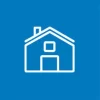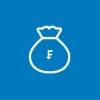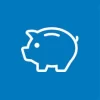Retirement funds are widely used within the Swiss pillar 3a category of tax-privileged retirement savings. They also serve as an investment vehicle for vested benefits from occupational pension funds. Retirement funds are much more complex than pillar 3a and vested benefits retirement savings accounts. Retirement accounts have few or no costs and pay interest at defined rates. Retirement funds have ongoing costs and returns are not guaranteed.
1. Total Expense Ratio (TER)
When bank employees and consultants mention fund costs, they are normally talking about total expense ratios (TERs).
The TER represents the total annual administrative costs of a fund. It is an annually recurring cost. The TER of a fund is shown as a percentage rate. This rate applies on an annual basis, and is calculated retroactively as a percentage of net asset value (NAV).
The TER’s of Swiss retirement funds generally range between 0.2% and 2% of NAV per annum. The average TER is just under 1% per annum. The TER is deducted directly from invested capital, rather than billed or charged to a bank account.
A more precise indicator, the synthetic TER, accounts for the costs charged by third-party funds in which the retirement fund invests. Swiss retirement funds are required to publish synthetic TER’s when fund shares make up 10% or more of their investment portfolios.
A fund with a TER (or a synthetic TER) of more than 1% per annum can be considered expensive. As a general rule, the larger the stock component of a fund, the higher its costs will be.
The term total expense ratio is somewhat misleading, because it does not account for the total cost of investing in a fund. Depending on the fund, additional brokerage fees, front end loads, back-end loads and custody fees may apply on top of the TER.
2. Front end loads
A sales charge – more commonly known as a front end load – is a fee charged by some funds when they issue fund shares to you as an investor. Front end loads are one-time fees which apply once when shares are purchased. The longer the investment term, the less significant this cost is to the total investment costs.
Front end loads are typically charged as a percentage of NAV. Front end loads fall into two categories: front end loads charged as an issuing fee; front end loads which are credited to fund assets.
Front end loads charged as an issuing fee represent a direct cost. You pay these fees to fund managers. Some banks and insurance companies charge front end loads as high as 2% of the capital you invest! Investing in funds with high front end loads is not recommended.
Front end loads which are credited to NAV are used to cover costs incurred through capital inflows or outflows.
How it works: When you invest money through a fund, the fund buys securities and other investments on your behalf, which generates investment costs. The front end load which you pay covers these investment costs, so that costs do not have to be deducted from the fund’s NAV. This protects existing investors from having to cover the costs of your investment. Front end loads credited to NAV act as a buffer against NAV dilution by helping to cover transaction costs. Rather than flowing into the pockets of fund managers, the front end loads are used to improve fund performance and deliver better returns to you as the investor.
This type of front end load is typically relatively low- The highest front end load credited to NAV charged by a Swiss retirement fund is 0.3%.
When a fund uses swing pricing, front end loads only apply when net inflows or outflows exceed a certain threshold on the day on which you purchase fund shares. These front end loads are then applied to the fund’s NAV to cover the exceptional investment costs.
3. Back-end loads
Deferred sales charges – popularly known as back-end loads – are similar to front end loads. The difference is that you pay these when you sell your fund shares. Like front end loads, back-end loads are a one-time cost which are calculated as a percentage of share value. They may be charged as a fee which goes to the fund manager, or they may be charged and credited towards the fund’s NAV. When a fund charges a back-end load, it is typically equal to or lower than the front end load charged by the same fund.
4. Custody fees
Securities held by a fund are owned by the fund and the custody fees charged for their safekeeping are included in the fund’s TER. However, your fund shares must be held in a custody account, and you will generally have to cover possible custodial fees yourself.
Custodial fees vary between custodian banks. Some banks do not charge custodial fees for the safekeeping of their own retirement funds. Others charge custodial fees as high as 1% of the value of your fund shares per annum.
5. Transaction fees
Some banks or third-party brokers charge brokerage fees when you buy or sell shares in a retirement fund. This cost is not included in the TER, nor covered by the front end load. Brokerage fees add an additional one-time cost which further detracts from returns.
6. Retrocession fees
Retrocession fees are commissions which funds pay to banks, brokers or consultants for onboarding you as a new customer. Most retirement funds do not pay retrocession fees.
Retrocession fees do not represent a cost for you as the investor. However, it is important to pay attention to these, as high retrocession fees can result in conflicts of interest. Banks and financial advisors may recommend certain retirement funds primarily because of the retrocession fees which they generate.
7. Compare total costs
The total cost of investing through a fund is one of the primary criteria to consider when choosing a retirement fund. Using a high-cost fund can cost your dearly in the way of lost returns.
Example: The total costs of some funds are up to 1% lower than those of some other funds. If you were to invest 50,000 francs through a retirement fund over 10 years, you would save 5000 Swiss francs by investing in the most affordable fund as opposed to the most expensive.
The interactive Swiss retirement fund comparison on moneyland.ch makes finding and comparing the total costs of retirement funds easy and fast. The comparison performs all of the complex calculations for you and lets you easily sort funds based on total costs.
The comparison also provides clear breakdowns of all costs applicable to each fund. Costs shown include: TER; synthetic TER; custodial fees; front end loads paid to the fund or credited to the fund’s NAV; back-end loads paid to the fund or credited to the fund’s NAV.
You can find information about possible retrocession fees and swing pricing on the information pages corresponding to each retirement fund.
More on this topic:
Interactive Swiss retirement fund comparison
Retirement fund tips








